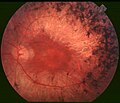Search results
Appearance
The page "Plant photoreceptor" does not exist. You can create a draft and submit it for review or request that a redirect be created, but consider checking the search results below to see whether the topic is already covered.
- organisms. Some examples are rhodopsin in the photoreceptor cells of the vertebrate retina, phytochrome in plants, and bacteriorhodopsin and bacteriophytochromes...8 KB (770 words) - 18:35, 10 May 2023
- Cryptochrome (category Plant cognition)circadian photoreceptor whereas CRY2 is a clock repressor which represses Clock/Cycle (Bmal1) complex in insects and vertebrates. In plants, blue-light...59 KB (6,478 words) - 20:52, 2 October 2024
- reflected or transmitted by plants because of the absorbance spectrum of chlorophyll, and it is perceived by the plant photoreceptor phytochrome. However, some...9 KB (1,047 words) - 09:04, 1 May 2024
- Botany (redirect from Plant biology)the photoreceptors in a plant that are sensitive to light. Plant anatomy is the study of the structure of plant cells and tissues, whereas plant morphology...138 KB (14,771 words) - 06:04, 1 October 2024
- Phytochrome (category Plant physiology)Phytochromes are a class of photoreceptor proteins found in plants, bacteria and fungi. They respond to light in the red and far-red regions of the visible...22 KB (2,831 words) - 15:37, 20 September 2024
- specialized photoreceptors, which are chemical pigments capable of absorbing specific wavelengths of light. Plants use four kinds of photoreceptors: phytochrome...30 KB (3,553 words) - 20:52, 18 May 2024
- Crosson, S.; Moffat, K. (2001). "Structure of a flavin-binding plant photoreceptor domain: Insights into light-mediated signal transduction". Proceedings...7 KB (480 words) - 04:03, 23 July 2023
- Crown shyness (category Plant morphology)sensing by adjacent plants. The photoreceptor-mediated shade avoidance response is a well-documented behavior in a variety of plant species. Neighbor detection...13 KB (1,369 words) - 12:43, 13 October 2024
- Crosson, S.; Moffat, K. (2001). "Structure of a flavin-binding plant photoreceptor domain: insights into light-mediated signal transduction". Proc Natl...12 KB (1,563 words) - 13:41, 22 July 2024
- Alan M. Jones (section Plant Hormone Receptors)1986. During his postdoctoral training, Jones established that the plant photoreceptor, phytochrome A, is dimeric and he showed a minimal structural unit...5 KB (695 words) - 12:09, 31 August 2024
- Eyespot apparatus (redirect from Photoreceptors, microbial)nature, composed of photoreceptors and areas of bright orange-red red pigment granules. Signals relayed from the eyespot photoreceptors result in alteration...7 KB (778 words) - 07:17, 8 March 2024
- Photopigment (section Photoreceptor pigments)photoreception. In medical terminology, "photopigment" commonly refers to the photoreceptor proteins of the retina. Photosynthetic pigments convert light into biochemical...3 KB (328 words) - 02:33, 16 July 2021
- Photoprotection (section In plants)variety of photoreceptors are used by plants to detect light intensity, direction and duration. In response to excess light, some photoreceptors have the...19 KB (2,119 words) - 02:03, 17 June 2024
- genes. The underlying mechanism involves the progressive loss of rod photoreceptor cells that line the retina of the eyeball. The rod cells secrete a neuroprotective...63 KB (6,338 words) - 18:53, 1 October 2024
- Photoperiodism (redirect from Long day plant)and a long-day plant can flower if exposed to more red-light in the middle of the night. Cryptochromes are another type of photoreceptor that is important...22 KB (2,676 words) - 04:39, 22 August 2024
- a growth response in the trained pea plant that is typically only triggered by the activation of photoreceptors. A replication study with a larger sample...22 KB (2,661 words) - 13:04, 20 August 2024
- documented biological clocks in plants are the day and seasonal cycles which are usually established by photoreceptors. Once a plant has established a pattern...27 KB (3,797 words) - 02:32, 16 September 2024
- physiology, ecology, and molecular biology. Many plant organs contain photoreceptors (phototropins, cryptochromes, and phytochromes), each of which reacts...48 KB (5,456 words) - 05:11, 30 July 2024
- Root (redirect from Plant roots)thaliana found that plants sense the Red to Far Red light ratio that enters the plant through photoreceptors known as phytochromes. Nearby plant leaves will absorb...50 KB (5,898 words) - 20:22, 13 October 2024
- Arabidopsis". Plant & Cell Physiology. 53 (9): 1517–34. doi:10.1093/pcp/pcs111. PMC 3439871. PMID 22864452. "Phototropins: Photoreceptors that provide...17 KB (2,027 words) - 18:50, 4 April 2024
- Not all bits have equal value. Carl Sagan & P.K. Ahnelt, (1998). "The photoreceptor mosaic." Eye 12(3B):531–540; as cited in: Stefan Winkler (2013). Digital
- needs something to detect light: photoreceptors. Even plants can react to light, and we can see this in the plants we have in our house, that grow toward











